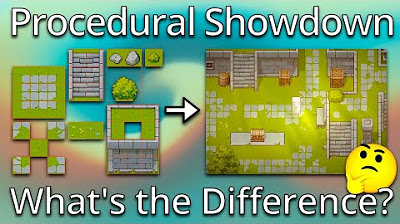Graph Grammar based Procedural Generation for a Roguelike
Summary
TLDR视频展示了一种用于生成roguelike游戏中的熔岩地形技术。该技术基于Voronoi单元算法,通过随机漫步在六边形网格上生成房间和走廊。通过图语法规则,系统能够创建出具有不同连通性和复杂性的地形。视频中还介绍了如何通过设置规则和限制来控制地形的生成,以及如何使用JavaScript实现Voronoi图。最终,这些技术在LOVE引擎中得到了应用,创造出多样化的游戏环境。
Takeaways
- 🔥 介绍了一种用于roguelike游戏的新型熔岩生成技术。
- 📐 该技术基于Voronoi细胞算法,从一组点生成凸多边形。
- 🔄 点是通过在六边形网格上进行随机漫步生成的。
- 🎨 颜色代表不同的游戏元素,如房间、走廊、墙壁等。
- 📊 通过图语法规则来构建和变化这些多边形。
- 🔄 图语法规则包括左侧的连接图和右侧的替换图。
- 🎲 规则的应用是随机的,可以设置限制以控制生成结果。
- 🔄 通过添加新的规则,可以创造出更复杂的房间和走廊结构。
- 🔄 规则可以细分和优化,以生成更多样化的关卡。
- 🚫 避免走廊交叉,除非明确要求。
- 🙏 感谢了多位专家和同事对项目的贡献和启发。
Q & A
这段视频中展示的是什么技术?
-视频中展示的是用于生成roguelike游戏地图的熔岩生成技术,它基于Voronoi单元算法,通过一组点生成凸多边形。
视频中提到的随机漫步是如何工作的?
-随机漫步是通过在六边形网格上进行随机移动来生成房间点,这些点随后用于Voronoi单元算法来创建地图。
视频中的颜色代表什么?
-颜色代表了地图的不同元素:房间用不同颜色表示,走廊用蓝绿色表示,灰色墙壁代表花岗岩,而周围的土壤和草地则用其他颜色表示。
视频中提到的图语法规则是什么?
-图语法规则由左侧的连接图和右侧的替换图组成。在生成过程中,左侧的图会被右侧的图随机替换,以创建房间和走廊。
如何控制生成的地图的连通性和循环性?
-可以通过设置图语法规则的应用次数或者通过给房间分配标签来控制地图的连通性和循环性。
视频中提到的“碰撞体积”是什么?
-“碰撞体积”是指房间的圆形表示,它确保两个房间之间总是可以创建走廊。
视频中展示的地图生成器如何处理房间的布局?
-地图生成器在生成过程中会移动房间,使它们不相交,然后尽可能地将它们紧密地聚集在一起。
视频中提到的“死胡同”是如何产生的?
-死胡同的产生可以通过调整图语法规则来控制,例如通过限制规则的应用次数或使用特定的规则组合。
视频中提到的“cosmetic”是什么意思?
-“Cosmetic”在这里指的是装饰性的,意味着某些线条(如房间边缘)即使重叠,也不会影响地图的有效性。
视频中提到的“subdivide”规则是什么?
-“Subdivide”规则是指将一个图形(如四边形)分割成更小的部分,例如将一个四边形分割成四个更小的四边形。
视频中感谢了哪些人?
-视频中感谢了David Adams(关于自动生成游戏地牢的论文作者),Raymond Hill(JavaScript Voronoi图实现者),以及Phil Ronson(同事,就地图生成进行了有益的讨论)。
Outlines

هذا القسم متوفر فقط للمشتركين. يرجى الترقية للوصول إلى هذه الميزة.
قم بالترقية الآنMindmap

هذا القسم متوفر فقط للمشتركين. يرجى الترقية للوصول إلى هذه الميزة.
قم بالترقية الآنKeywords

هذا القسم متوفر فقط للمشتركين. يرجى الترقية للوصول إلى هذه الميزة.
قم بالترقية الآنHighlights

هذا القسم متوفر فقط للمشتركين. يرجى الترقية للوصول إلى هذه الميزة.
قم بالترقية الآنTranscripts

هذا القسم متوفر فقط للمشتركين. يرجى الترقية للوصول إلى هذه الميزة.
قم بالترقية الآنتصفح المزيد من مقاطع الفيديو ذات الصلة

Generative grammars as a form of procedural content generation

Acrobatic Stick ll NCSM Science Education Series

Past Times Pinball History Ep 7: Black Knight

Procedural Generation in Unity

Procedural Generation with Wave Function Collapse and Model Synthesis | Unity Devlog

Alex Byaly: Causal Graphs for Procedural Generation
5.0 / 5 (0 votes)
